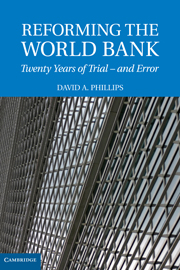Book contents
- Frontmatter
- Contents
- Preface: The Search for Effectiveness in the World's Premier Development Institution
- REFORMING THE WORLD BANK
- PART I ORIGINS AND EVOLUTION
- PART II THE SEARCH FOR EFFECTIVENESS
- 3 Fifty Years of Bank Reforms
- 4 The 1990s – Re-Engineering the Organization
- 5 Changing Culture and Changing People
- 6 Reforming the Bank's Assistance Product
- 7 Changing the Quality of Development Assistance
- 8 Financing the Reorganization
- 9 Why Did the Reforms Fail?
- PART III TOWARDS REAL REFORM: THE GOVERNANCE AGENDA
- Index
6 - Reforming the Bank's Assistance Product
Published online by Cambridge University Press: 25 January 2011
- Frontmatter
- Contents
- Preface: The Search for Effectiveness in the World's Premier Development Institution
- REFORMING THE WORLD BANK
- PART I ORIGINS AND EVOLUTION
- PART II THE SEARCH FOR EFFECTIVENESS
- 3 Fifty Years of Bank Reforms
- 4 The 1990s – Re-Engineering the Organization
- 5 Changing Culture and Changing People
- 6 Reforming the Bank's Assistance Product
- 7 Changing the Quality of Development Assistance
- 8 Financing the Reorganization
- 9 Why Did the Reforms Fail?
- PART III TOWARDS REAL REFORM: THE GOVERNANCE AGENDA
- Index
Summary
There were many flaws in the processes of reform of the 1990s. But even if the processes were per se flawed, this does not necessarily mean that the product was also flawed. The new organizational structures and processes were the immediate outcomes of the reforms, but the actual products delivered, in terms of both type and quality, would reflect the ultimate impact of the reforms, and it is in the final analysis the impact that is important.
The Strategic Compact called for change in the quality and types of products, within the overall objective of poverty reduction. The aim was both a process one, to make the Bank's products more responsive to the needs of clients, and one of content. Stemming from Wolfensohn's 1996 ‘knowledge bank’ announcement, the principal content change was to accelerate the diversification from lending projects to knowledge and information projects and services. Following the Strategic Compact, another key process change was the emphasis on projects that used a participatory development approach. How far in fact did the reforms put in place under the Strategic Compact improve or worsen the product menu?
THE BANK'S PRODUCTS – A RECAP
As discussed inChapter 1, the Bank's rationale for assistance can be conceived as having evolved essentially through three stages: a) capital deficiency; b) capital deficiency and related skill/know-how deficiency; and c) capacity, know-how, and ‘information’ deficiency. In accordance with this evolution the Bank has shifted from its initial role as a financier of infrastructure and industry.
- Type
- Chapter
- Information
- Reforming the World BankTwenty Years of Trial - and Error, pp. 119 - 154Publisher: Cambridge University PressPrint publication year: 2009

